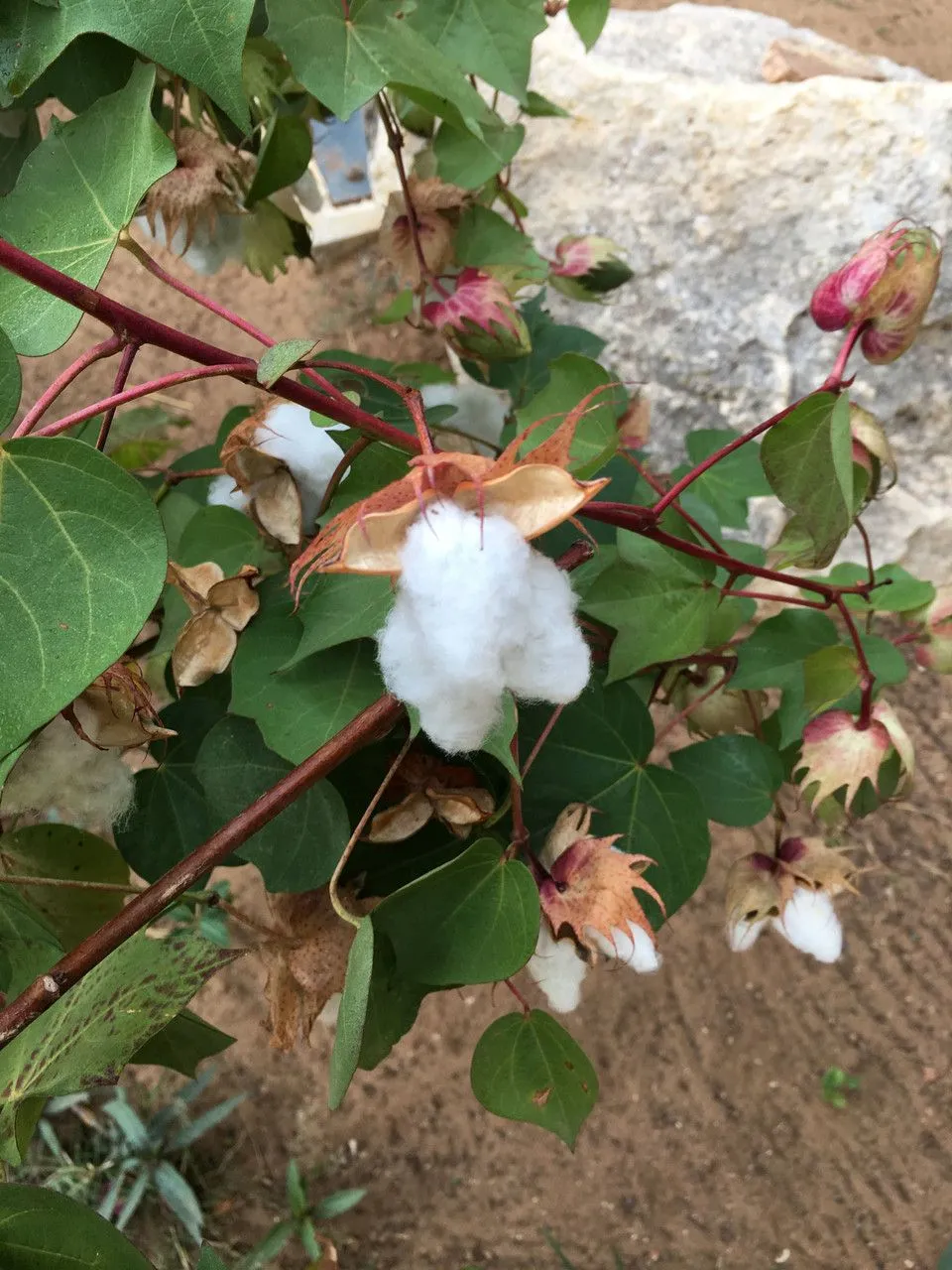
Author: L.
Bibliography: Sp. Pl.: 693 (1753)
Year: 1753
Status: accepted
Rank: species
Genus: Gossypium
Vegetable: False
Observations: Syria to Afghanistan
Arabian cotton, known scientifically as Gossypium herbaceum, is a prominent species notable within the botanical landscape, particularly prevalent from Syria extending to Afghanistan. This species is a valuable member of the Malvaceae family, a group renowned for containing plants of both economic and ecological significance.
First described in the seminal work “Species Plantarum” in 1753 by Carl Linnaeus, Gossypium herbaceum has since drawn considerable attention for its resilient nature and historical importance in textile production. The hardy nature of Arabian cotton allows it to thrive in the arid and semi-arid climates found in its native range, making it particularly well-suited to the environmental conditions across this expanse of the Middle East and Central Asia.
Arabian cotton is characterized by a robust growth habit, often presenting as a shrub. The plant bears soft, fluffy fibers that develop in protective capsules around the seeds. These fibers, once harvested, have been traditionally spun into threads, woven into textiles, and used globally, marking Arabian cotton as a vital commodity in the ancient and modern fabric industry.
Its significance is not merely historical; even today, research explores its genetic composition and potential uses. Gossypium herbaceum continues to contribute to breeding programs aimed at enhancing cotton resilience, pest resistance, and fiber quality, supporting ongoing agricultural sustainability and economic stability in regions where it is cultivated.
In addition to its economic contributions, Arabian cotton plays a role in local ecosystems, providing habitat and food for various insects and other small wildlife, illustrative of the interconnectedness between agriculture and environmental health.
In summary, Arabian cotton, Gossypium herbaceum, stands as a testament to the enduring relationship between human societies and plant resources, embodying a legacy of adaptation, utility, and ongoing scientific interest that spans centuries and continents.
Eng: arabian cotton, levant cotton, maltese cotton, syrian cotton, short-staple cotton, cultivated cotton
Mlt: qotin malti
Por: algodoeiro-asiático, algodoeiro
Spa: algodonero, algodonero herbáceo
Fra: cotonnier d’asie, cotonnier herbacé, cotonnier africain
Deu: gewöhnliche baumwolle, krautiger baumwollstrauch
Swe: indisk bomull
Ell: vamvaki
Zho: cao mian
Amh: garatita, girbi, wdibi
Jpn: shiro-bana-wata
En: Arabian cotton, Levant cotton, Maltese cotton, Syrian cotton, Short-staple cotton, Cultivated cotton, Wild cotton, Cotton Root
Af: Wildekatoen
Am: Garatita, Girbi, Wdibi
Zh: Cao mian
Fr: Cotonnier d’Asie, Cotonnier herbacé, Cotonnier africain
De: Gewöhnliche Baumwolle, Krautiger Baumwollstrauch
El: Vamvaki
Ja: Shiro-bana-wata
Mt: Qotin malti
Pt: Algodoeiro-asiático, Algodoeiro
Es: Algodonero, Algodonero herbáceo
Sv: Indisk bomull
Taken Mar 15, 2019 by Julien Champ (cc-by-sa)
Taken Mar 19, 2017 by arundina (cc-by-sa)
Taken Feb 26, 2018 by Tela Botanica − Liliane ROUBAUDI (cc-by-sa)
Taken May 16, 2020 by Neumann Anja (cc-by-sa)
Taken Mar 19, 2017 by arundina (cc-by-sa)
Taken Jun 13, 2016 by Hugo SANTACREU (cc-by-sa)
Taken Nov 25, 2021 by Esdras Castro (cc-by-sa)
Taken Nov 25, 2021 by Esdras Castro (cc-by-sa)
Taken Mar 15, 2019 by Julien Champ (cc-by-sa)
Taken May 22, 2008 by Jean-Yves Guezenec (cc-by-sa)
Taken Apr 14, 2015 by Tela Botanica − Hugo SANTACREU (cc-by-sa)
Taken Apr 26, 2019 by Moussa Fall (cc-by-sa)
Taken Apr 16, 2022 by Karol Salas (cc-by-sa)
Taken Apr 14, 2015 by Tela Botanica − Hugo SANTACREU (cc-by-sa)
Taken Aug 31, 2017 by Richard Ballas (cc-by-sa)
Taken Jan 23, 2010 by Tela Botanica − Geneviève Botti (cc-by-sa)
Taken Sep 27, 2013 by Tela Botanica − Hugo SANTACREU (cc-by-sa)
Taken Apr 14, 2015 by Tela Botanica − Hugo SANTACREU (cc-by-sa)
Taken Feb 26, 2018 by Tela Botanica − Liliane ROUBAUDI (cc-by-sa)
Taken Nov 16, 2022 by M. Hedayat (cc-by-sa)
Taken Apr 26, 2016 by Manie Maree (©)
Taken Apr 26, 2016 by Manie Maree (©)
Taken Jul 6, 2019 by alderash (cc-by-sa)
Taken Nov 16, 2022 by M. Hedayat (cc-by-sa)
Taken Jun 13, 2016 by Hugo SANTACREU (cc-by-sa)
Taken Jul 9, 2022 by M. Hedayat (cc-by-sa)
Taken Nov 16, 2022 by M. Hedayat (cc-by-sa)
Taken Jun 15, 2019 by Yahya Rahimpour (cc-by-sa)
Taken Apr 26, 2016 by Manie Maree (©)
Taken Apr 26, 2016 by Manie Maree (©)
© copyright of the Board of Trustees of the Royal Botanic Gardens, Kew.
© copyright of the Board of Trustees of the Royal Botanic Gardens, Kew.
© copyright of the Board of Trustees of the Royal Botanic Gardens, Kew.
Family: Myrtaceae Author: (F.Muell.) K.D.Hill & L.A.S.Johnson Bibliography: Telopea 6: 402 (1995) Year: 1995 Status:…
Family: Rubiaceae Author: Pierre ex A.Froehner Bibliography: Notizbl. Bot. Gart. Berlin-Dahlem 1: 237 (1897) Year:…
Family: Sapindaceae Author: Koidz. Bibliography: J. Coll. Sci. Imp. Univ. Tokyo 32(1): 38 (1911) Year:…
Family: Asteraceae Author: A.Gray Bibliography: Pacif. Railr. Rep.: 107 (1857) Year: 1857 Status: accepted Rank:…
Family: Fabaceae Author: Medik. Bibliography: Vorles. Churpfälz. Phys.-Ökon. Ges. 2: 398 (1787) Year: 1787 Status:…
Family: Aspleniaceae Author: (Cav.) Alston Bibliography: Bull. Misc. Inform. Kew 1932: 309 (1932) Year: 1932…